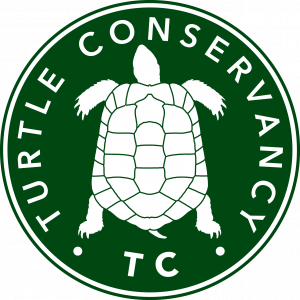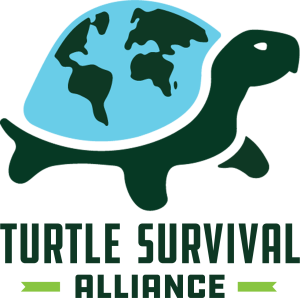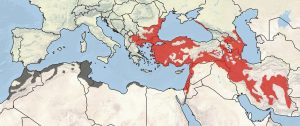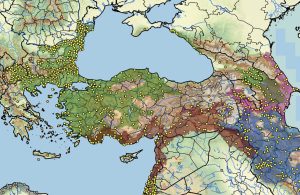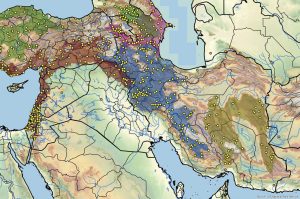Testudo graeca (Eastern Subspecies Clades), 120
Testudo graeca Linnaeus 1758 (Eastern Subspecies Clades:
Testudo g. armeniaca, Testudo g. buxtoni, Testudo g. ibera, Testudo g. terrestris, Testudo g. zarudnyi) – Armenian Tortoise, Zagros Tortoise, Anatolian Tortoise, Levantine Tortoise, Kerman Tortoise
Oguz Türkozan1,2, Hossein Javanbakht3, Liudmila Mazanaeva4,
Shai Meiri5, Yurii V. Kornilev6,7,8, Elias Tzoras9,
Georgi Popgeorgiev6,10, Uri Shanas11, and Daniel Escoriza12
1Aydın Adnan Menderes University, Faculty of Science,
Department of Biology, Aydın 09100, Türkiye (Turkey) [[email protected]];
2Cyprus Wildlife Research Institute, Kyrenia, Northern Cyprus;
3Department of Biology, Faculty of Science, University of Guilan,
Rasht 41996-13776, Iran [[email protected]];
4Daghestan State University, Makhachkala, Dagestan 367000, Russia [[email protected]];
5School of Zoology and Steinhardt Museum of Natural History,
Tel Aviv University, Tel Aviv 6997801, Israel [[email protected]];
6Vertebrates Department, National Museum of Natural History, Bulgarian Academy of Sciences,
1000 Sofia, Bulgaria [[email protected], [email protected]];
7Unit for Integrative Zoology, Department of Evolutionary Biology, Vienna University, 1010 Vienna, Austria;
8Institute of Zoology, University of Natural Resources and Life Sciences (BOKU), 1180 Vienna, Austria;
9Patra, 264 42 Achaia, Greece [[email protected]];
10Bulgarian Society for the Protection of Birds/BirdLife Bulgaria;
11Biology and Environment, University of Haifa – Oranim, Tivon 36006, Israel [[email protected]];
12Grup de Recerca en Ecologia Aquàtica Continental (GRECO), University of Girona,
Campus Montilivi, 17071 Girona, Spain [[email protected]]
Summary. − The eastern clades of the Spur-thighed Tortoise, Testudo graeca (Family Testudinidae), include small to medium-sized (maximum straightline carapace lengths [SCL] typically ≤ 30 cm, but possibly up to 46.0 cm) tortoise subspecies clades native to the Balkans (southeastern Europe) and southwestern Asia. Within this vast geographic distribution, the species occupies Mediterranean, Mediterranean-continental, and steppe climates, as well as the margins of hot deserts. In southeastern Turkey and Iran, it reaches elevations of 2500 m, the record for the species. Testudo graeca is characterized by the presence of a small conical keratinous spur on each posterior thigh, present in all eastern clade subspecies. The eastern clades show a very high degree of phenotypic variability, ranging from almost entirely black individuals (typically, but not exclusively in the north of its range) to yellowish (flavistic) individuals (primarily in southern Israel). They also show variability in the structure and shape of the carapace, ranging from flatter steppe forms to domed, higher-shelled forms. In general, adult females are slightly larger and heavier than males in most eastern clade regions and studied populations; however, in approximately 30% of surveyed populations across the range, males reach a similar or larger average size, and the few largest individuals recorded of the species are males. Female mean SCLs among the eastern subspecies clades range from 14.5–21.9 cm per region or population, with mean body mass ranging from ca. 700–2250 g (average ca. 1630 g); male mean SCLs range from 13.5–24.1 cm with mean body mass ranging from ca. 420–2700 g (average ca. 1560 g). Male dimorphic characters include a proportionally longer and thicker tail and plastral concavity. Females produce 1–3 clutches of 2–19 eggs annually between May and July. The species is still relatively common and widespread in a large part of its range. Some populations have declined drastically since the second half of the 20th century (as in Azerbaijan) and in others this decline has accelerated more recently, mainly in southwestern Russia, Armenia, and in the coastal regions of Israel. The main threats to the eastern subspecies clades of T. graeca are the degradation and loss of habitats by urbanization and development, bush fires, and agricultural mechanization, while the legal collection for the international pet trade, especially to Europe, is currently much more regulated than in previous decades.
Distribution. – Southeastern Europe and southwestern Asia, including Bulgaria, Greece, Kosovo, North Macedonia, Romania, Russia, Serbia, Turkey (Türkiye), Armenia, Azerbaijan, Georgia, Iran, Iraq, Israel, Jordan, Lebanon, Palestine, and Syria.
Synonymy. – Testudo graeca Linnaeus 1758, Testudo terrestris Forskål 1775, Testudo ecaudata Pallas 1814, Testudo ibera Pallas 1814, Testudo zarudnyi Nikolsky 1896, Testudo ibera bicaudalis Venzmer 1920, Testudo buxtoni Boulenger 1921, Testudo ibera racovitzai Călinescu 1931, Testudo floweri Bodenheimer 1935, Testudo graeca nikolskii Chkhikvadze and Tuniev 1986, Testudo graeca anamurensis Weissinger 1987, Testudo graeca armeniaca Chkhikvadze and Bakradze 1991, Testudo antakyensis Perälä 1996, Testudo graeca pallasi Chkhikvadze and Bakradze 2002, Testudo perses Perälä 2002, Testudo dagestanica Chkhikvadze, Mazanaeva, and Shammakov 2011.
Subspecies . – Based on molecular analyses and some morphological traits, five subspecies are currently recognized among the eastern clades of the Spur-thighed Tortoise: T. g. armeniaca, Armenian Tortoise, Araxes Tortoise (Armenia, Azerbaijan, Iran, Russia [Dagestan], Turkey); T. g. buxtoni, Zagros Tortoise, Buxton’s Tortoise (Iran, Iraq, Turkey); T. g. ibera, Anatolian Tortoise, Greek Tortoise, Asia Minor Tortoise (Bulgaria, Georgia, Greece, Kosovo, North Macedonia, Romania, Russia [Krasnodar], Serbia, Turkey); T. g. terrestris, Levantine Tortoise, Mesopotamian Tortoise (Israel, Jordan, Lebanon, Palestine, Syria, Turkey); and T. g. zarudnyi, Kerman Tortoise, Iranian Tortoise (Iran).
Status. – IUCN 2022 Red List: Vulnerable (VU A1cd, assessed 1996); Regional (Europe): Vulnerable (VU A2bcde+4bcde, assessed 2009); CITES: Appendix II, as Testudinidae spp.; EU: Annex A (regulation of trade of fauna and flora); Bern Convention: Annex II; Bulgaria: Endangered (EN A3aс); North Macedonia: Vulnerable; Greece: Least Concern; Iran: Vulnerable; Israel: Vulnerable (VU A1cd).
Citation:
Türkozan, O., Javanbakht, H., Mazanaeva, L., Meiri, S., Kornilev, Y.V., Tzoras, E., Popgeorgiev, G., Shanas, U., and Escoriza, D. 2023. Testudo graeca Linnaeus 1758 (Eastern Subspecies Clades: Testudo g. armeniaca, Testudo g. buxtoni, Testudo g. ibera, Testudo g. terrestris, Testudo g. zarudnyi) – Armenian Tortoise, Zagros Tortoise, Anatolian Tortoise, Levantine Tortoise, Kerman Tortoise. In: Rhodin, A.G.J., Iverson, J.B., van Dijk, P.P., Stanford, C.B., Goode, E.V., Buhlmann, K.A., and Mittermeier, R.A. (Eds.). Conservation Biology of Freshwater Turtles and Tortoises: A Compilation Project of the IUCN/SSC Tortoise and Freshwater Turtle Specialist Group. Chelonian Research Monographs 5(17):120.1–33. doi: 10.3854/crm.5.120.eastern.graeca.v1.2023; www.iucn-tftsg.org/cbftt/.
Adobe Acrobat 6.0 or later required)
Adult female Armenian Tortoise, Testudo graeca armeniaca, on the western shores of the Caspian Sea, Derbentsky District, Dagestan, Russia.
Photo by Liudmila Mazanaeva.
Distribution:
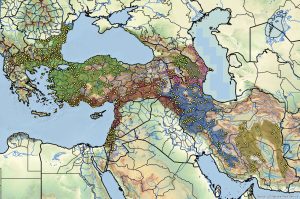
Figure 11a. Top: Outline map of total Testudo graeca estimated historical indigenous distribution; gray = western subspecies clade (see TTWG 2021 and Escoriza et al. 2022); red = eastern subspecies clades (see below). Bottom: Overall distribution of the eastern subspecies clades of Testudo graeca in southeastern Europe and southwestern Asia. Yellow dots = museum and literature occurrence records of native populations based on Iverson (1992), other more recent literature records (see TTWG 2017, 2021), and authors’ additional data; orange dots = introduced or possibly historically relict populations or individual trade or translocated specimens; gray dots and gray shading = eastern extent of the western subspecies clade of T. graeca (= T. g. cyrenaica); colored shading = estimated historical indigenous ranges of: 1) T. g. armeniaca = purple; 2) T. g. buxtoni = blue; 3) T. g. ibera = green; 4) T. g. terrestris = brown; and 5) T. g. zarudnyi = olive; colored shading overlap areas = hybridization zones and intergrades (armeniaca–ibera, armeniaca–buxtoni, ibera–terrestris, and buxtoni–terrestris). Distribution based on fine-scaled GIS-defined level 12 HUCs (hydrologic unit compartments) constructed around verified localities and then adding HUCs that connect known point localities in the same watershed or physiographic region, and similar habitats and elevations as verified HUCs based on Buhlmann et al. (2009), TTWG (2017, 2021), and data from authors and other sources.
Figure 11b. Top: Enlarged view of the northwestern distribution of the eastern subspecies clades of Testudo graeca. Bottom: Enlarged view of the southeastern distribution of the eastern subspecies clades of Testudo graeca. Legend for dots and color shadings as in Figure 11a.




